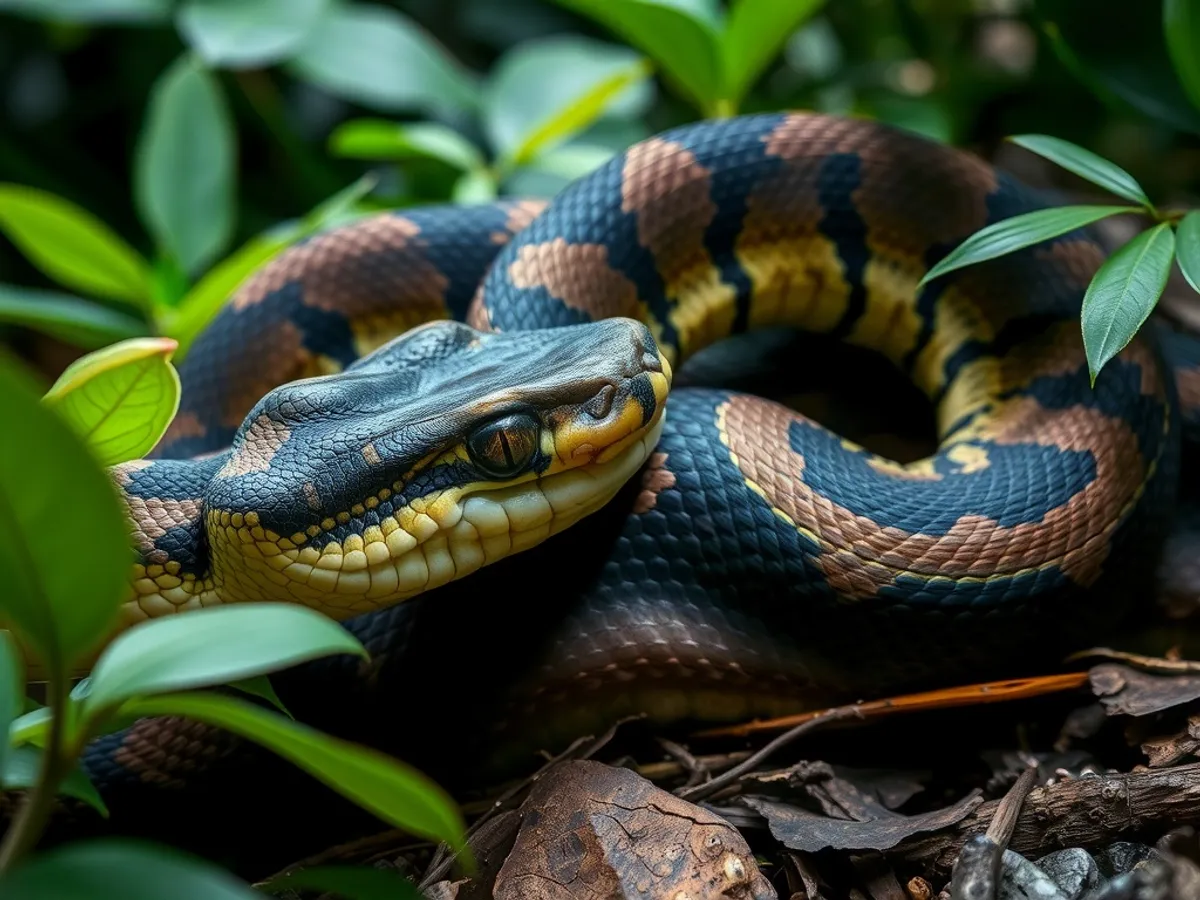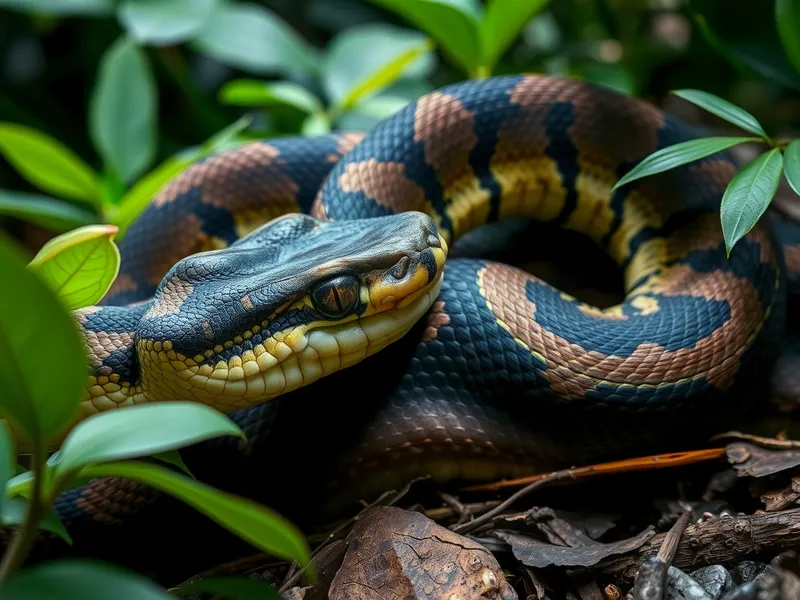
Reticulated Python
Malayopython reticulatus

Meet the Reticulated Python
The Reticulated Python is the world's longest snake species, renowned for its striking geometric skin pattern. Native to Southeast Asia, it inhabits rainforests, woodlands, and grasslands, often near water sources. This non-venomous constrictor feeds primarily on mammals and birds, using its muscular body to subdue prey. Reticulated Pythons are excellent swimmers and climbers, adapting well to both wild and human-altered environments. Despite their size and strength, they are generally not considered aggressive toward humans unless provoked.
Classification
Reptile
Habitat
Tropical rainforest
Diet
Carnivore
Lifespan
15–25 years
Conservation
Least Concern
Weight
30–160 kg
📖Fascinating Facts
World's Longest Snake
The Reticulated Python holds the record for the longest snake ever reliably measured, with some individuals growing over 7 meters (23 feet) long.
Expert Swimmer
This species is an adept swimmer and is often found near rivers, lakes, and even swimming across ocean channels between islands.
Large Prey Hunter
Reticulated Pythons are capable of hunting large prey, including pigs, deer, and occasionally even primates, thanks to their powerful constricting muscles.
📋Detailed Description
The reticulated python (Malayopython reticulatus) is the world’s longest snake, with verified specimens regularly exceeding 6 meters in length and some exceptional individuals reaching over 8 meters, though most adults average 3–6 meters. It has a slender yet powerfully muscular body, covered in smooth, iridescent scales arranged in a complex net-like (reticulated) pattern of gold, black, white, and brown, providing effective camouflage among leaf litter and forest shadows. The head is elongated with a pronounced snout and heat-sensing pits along the upper lip, allowing detection of warm-blooded prey even in darkness. The eyes have vertical pupils, an adaptation for nocturnal activity. Reticulated pythons are primarily solitary and secretive, spending much of their time concealed in dense vegetation or near water bodies. They are both terrestrial and arboreal, capable climbers and exceptional swimmers, often traveling between islands and across rivers. Their jaws are highly flexible, enabling them to consume prey much larger than their head diameter. As non-venomous constrictors, they subdue prey by coiling around it and suffocating it before swallowing it whole. Lifespans in the wild are estimated at 15–22 years, with some individuals in captivity living over 25 years. This species exhibits sexual dimorphism, with females generally larger and more robust than males, especially during the breeding season.
💡 Did you know?
Despite their massive size, Reticulated Pythons are agile swimmers and can travel between islands in their native range.
🔬Research & Sources
Wikipedia Summary
The reticulated python is a python species native to South and Southeast Asia. It is the world's longest snake, and the third heaviest snake. It is a non-venomous constrictor and an excellent swimmer that has been reported far out at sea. It has colonized many small islands within its range. Because of its wide distribution, it is listed as least concern on the IUCN Red List. In several countries in its range, it is hunted for its skin, for use in traditional medicine, and for sale as pets. Due to this, it is one of the most economically important reptiles worldwide. In very rare cases, reticulated pythons killed and swallowed adult humans.
Last Modified: 6/2/2025
🎭Behavior & Social Structure
Reticulated pythons are predominantly nocturnal, emerging at dusk to hunt. They are ambush predators, relying on stealth and patience, often lying motionless for hours or days along animal trails or water edges. Their diet is highly opportunistic and includes mammals (such as rodents, civets, primates, and occasionally pigs or deer), birds, and occasionally reptiles. Large individuals have been documented preying on animals as large as sun bears or domestic livestock. They use their heat-sensing pits to locate endothermic prey in low light. After a successful strike, the python coils rapidly around the prey, tightening its grip with each exhalation until the animal succumbs. Feeding frequency is low; a large meal can sustain an adult for weeks or even months. Social interactions are minimal outside of the breeding season, and individuals are generally territorial. Reticulated pythons are known to bask in the sun during the day, especially after feeding to aid digestion, but otherwise remain hidden to avoid predation and disturbance.
👶Reproduction & Life Cycle
Breeding typically occurs during the rainy season, varying geographically but often between December and March. Males locate receptive females via pheromone trails, and courtship may involve tactile stimulation and body alignment. Males may engage in combat for access to females, though this is less common than in some other python species. Females are oviparous, laying clutches of 15–80 eggs (average 25–50) in concealed, humid locations such as hollow logs or burrows. Incubation lasts 80–90 days, during which the female coils around the eggs and shivers to generate heat, maintaining optimal temperatures of 31–32°C (88–90°F). This maternal brooding is a notable form of parental care, but once the eggs hatch, neonates are independent and receive no further care. Hatchlings measure 60–80 cm and are immediately capable of hunting small prey.
🛡️Adaptations & Survival
Reticulated pythons possess several key adaptations for survival: their cryptic coloration provides camouflage in varied habitats, while their prehensile tail aids in climbing. The presence of labial heat-sensing pits allows them to detect prey in total darkness. Their highly kinetic skull and loosely articulated jaws enable ingestion of prey up to one-quarter of their own body weight. The species’ ability to swim long distances—documented up to several kilometers offshore—facilitates dispersal to islands, explaining their wide distribution. Slow metabolism allows them to survive extended periods without food. Their robust musculature provides the strength necessary for constriction, and their ability to regulate body temperature behaviorally (basking, seeking shade or water) is crucial in tropical climates.
📚Research Sources
🎨Cultural Significance
Reticulated pythons hold a prominent place in the folklore and mythology of Southeast Asia, often symbolizing power, danger, or transformation. In some cultures, they are revered as guardians or spirit animals, while in others, they are feared and associated with omens. Their skins are highly valued for leather goods, making them economically significant in the global fashion industry. In traditional medicine, various body parts are used for purported healing properties, though there is no scientific basis for these claims. The species is also featured in local legends and has occasionally been kept as a status symbol or curiosity in private collections and zoos.
🔬Recent Research & Discoveries
Recent genetic studies have clarified the taxonomy of the reticulated python, leading to its placement in the genus Malayopython, distinct from other large Asian pythons. Population genetics research has revealed significant genetic structuring among island and mainland populations, suggesting limited gene flow and potential cryptic diversity. Studies on their ecological role highlight their importance as apex predators in controlling populations of small to medium-sized mammals and birds. Research into their physiological adaptations, such as extreme metabolic flexibility and rapid organ growth following feeding, has provided insights into vertebrate digestion and metabolism. Ongoing studies are assessing the sustainability of harvest for the skin trade and the impact of habitat fragmentation on genetic diversity.
🎥Wildlife Videos

Pythons 101 | National Geographic
From unbelievably flexible jaws to rows of razor sharp teeth, a range of impressive features make the python one of nature's most ...
National Geographic

Nat Geo Wild - The Life Of The Pythons - National Geographic
Nat Geo Wild - The Life Of The Pythons - National Geographic Secret Pythons.
The Wild Animal Channel

Feeding a Reticulated Python | Secrets of the Zoo: Down Under
About National Geographic Wild: National Geographic Wild is a place for all things animals and for animal-lovers alike. Take a ...
Nat Geo Animals

Austin Stevens Reticulated Python
Austin Stevens catches a Reticulated Python!
Tristan Clark

Pythons that Eat People
Let's take a look at some attacks from Reticulated Pythons. Please consider supporting the channel: ...
Wild World

Giant Burmese Pythons Invade Florida's Wetlands | Python Hunters | Real Wild
Join the Python Hunters on their thrilling expedition deep into the heart of the Everglades. This dynamic trio, comprising a biologist ...
Real Wild
🌍Habitat Information
The Reticulated Python typically inhabits Tropical rainforest environments. Reticulated Pythons have adapted to their environments with specialized features and behaviors.
Primary Habitat:
Tropical rainforest
More detailed habitat information will be available soon.
🛡️Conservation Status
The Reticulated Python is currently classified as Least Concern. Conservation efforts are crucial for preserving this species for future generations.
Common Threats:
- 🏠Habitat loss and fragmentation
- 🌡️Climate change impacts
- 🎯Hunting and poaching
- 🏭Human-wildlife conflict
⚠️Threats & Conservation Challenges
Despite being listed as Least Concern by the IUCN due to their wide range and presumed large population, reticulated pythons face significant threats. Overharvesting for the international skin trade, traditional medicine, and the exotic pet industry has led to localized population declines, especially near human settlements. Habitat loss from deforestation, agricultural expansion, and urbanization further threatens their habitats. Road mortality and persecution due to fear or livestock predation are additional concerns. While the species shows resilience and adaptability, ongoing exploitation and habitat fragmentation could pose future risks, and some island populations may be more vulnerable than mainland ones. Monitoring and sustainable management of trade are ongoing conservation challenges.
🔬Scientific Classification
Scientific Name
Malayopython reticulatus
Classification Hierarchy
🔍 About Taxonomic Classification
Taxonomic classification is a hierarchical system used by scientists to classify and organize living organisms based on shared characteristics and evolutionary relationships.
The system moves from broad categories (Kingdom) to increasingly specific ones, with each animal's scientific name typically consisting of its Genus and species.
📝Community Notes
Share your observations and insights about the Reticulated Python with our community of wildlife enthusiasts.
Join Our Community
Sign in to share your observations and connect with fellow wildlife enthusiasts.
Sign In to ContributeNo community notes yet
Be the first to share your observations about the Reticulated Python!
Explore Reticulated Python
Select a tab above to learn more about this amazing animal.
📸Photo Gallery
No photos available for this animal yet.
🌟Discover More Wildlife
Continue your journey of discovery with more fascinating animals from our database
